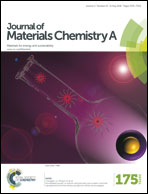Solution-processed sulfur depleted Cu(In, Ga)Se2 solar cells synthesized from a monoamine–dithiol solvent mixture†
Abstract
Molecular precursor processing from homogeneous and stable precursor solutions has become an important thrust in inorganic thin-film research because of its potential to provide low-cost, robust, and high-throughput deposition of various semiconductor films and devices. Here we demonstrate a versatile monoamine–dithiol mixture which possesses the remarkable ability to rapidly dissolve a variety of metal salts and metal chalcogenides under ambient conditions for the fabrication of device quality Cu(In, Ga)Se2 (CIGSe) films. By using soluble precursors, an ultrathin CIGSe film solar cell with an undetectable level of sulfur with an efficiency of 10.3% has been fabricated for a total cell area of 0.457 cm2. We further report an optimization study of the film composition and grain growth for a thicker CIGSe absorber layer, which has led to an increased solar cell efficiency of 12.2%, the highest reported values for solar cells using an amine–thiol solvent system. This study outlines a simple strategy to formulate inorganic semiconductor inks for processing high-quality selenide absorber layers of multinary compounds, which shows promise for increasing the efficiency of solution-processed thin-film solar cells.


 Please wait while we load your content...
Please wait while we load your content...